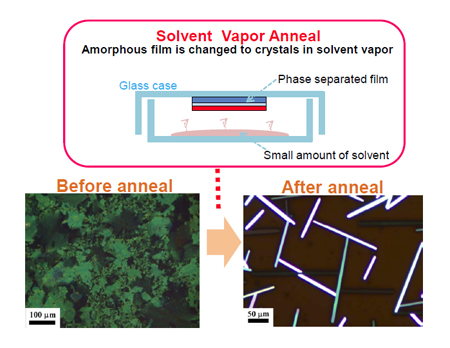High Mobility Organic Transistor from Solution
Fabrication of the World’s Highest Mobility Organic Crystal Transistor by Simple Process of Solution Dripping and Exposure to Vapor
2010.11.29
National Institute for Materials Science
A team headed by Dr. Kazuhito Tsukagoshi, a PI at the MANA, NIMS, succeeded in fabricating an organic transistor with the world's highest field effect mobility directly on a substrate by developing solution process for producing organic crystal transistor from solution.
Abstract
- A team headed by Dr. Kazuhito Tsukagoshi, a Principal Investigator at the International Center for Materials Nanoarchitectonics (MANA; Director-General: Masakazu Aono), National Institute for Materials Science (President: Sukekatsu Ushioda), in joint research with Professor Kazuo Takimiya of Hiroshima University, succeeded in fabricating an organic transistor with the world's highest field effect mobility directly on a substrate by developing solution process for producing organic crystal transistor from solution.
- With the development of mobile devices such as notebook PCs and electronic books, portability of information/image media is progressing. However, liquid crystal displays, which are currently the mainstream technology, are produced on a glass substrate due to limitations on the transistor manufacturing temperature. Although thinner glass substrates are required in order to reduce weight and thereby improve portability, there are limits to glass thickness, as glass substrate displays have low impact resistance and are easily broken. To solve this problem, if organic transistors can be used, it will be possible to manufacture high performance pixel-drive transistor arrays on plastic substrates, which offer the combined advantages of light weight and flexibility.
- In this work, the researchers independently developed a method that makes the fullest possible use of self-assembly, in which crystals are formed by spontaneous overlaying of organic molecules. High performance organic crystal transistors can be produced simply by spin-coating the material, which is dissolved in an organic solvent, on a substrate, and then exposing the material to a solvent vapor for several hours. Normally, organic thin film devices contain a large number of crystal grain boundaries, which reduce conductivity. However, this crystal film contains no grain boundaries, and high characteristics can be obtained even when the film is fabricated in air. A transistor which was fabricated using this crystal achieved the world’s highest field effect mobility of 9.1cm2/Vs in a transistor produced from a solution. This is a dramatic improvement in comparison with the field effect mobility of many devices produced by general solution methods, which is limited to approximately 1cm2/Vs.
- With conventional organic semiconductor single crystals, where electrical conductivity is concerned, mobility increases when the device is cooled, reaching at peak at around -70°C, and then decreases at lower temperatures. However, with the device produced by this method, mobility increased continuously in measurements down to -200°C, and there was no scattering of electrical conductivity due to crystal grain boundaries, etc. Although the mechanism of conduction in organic crystal semiconductors had been disputed until now, this result also clarified the fact that the mechanism responsible for conduction is band-type conduction.
- This method is simple and does not require a vacuum device, etc., and it easily improves the properties of organic semiconductors. In the future, application to roll-type continuous processes will also be possible, and it will be effective in research aimed at realizing flexible information/image media.
- This research was carried out as part of the research topic "High Operating Speed Organic Transistors by Nano Interface/Electronic State Control" (Research Representative: Kazuhito Tsukagoshi) in the research field "Establishment of Innovative Manufacturing Technology based on Nanoscience" (Research Supervisor: Yasuhiro Horiike, Emeritus Fellow, National Institute for Materials Science) in the Japan Science and Technology Agency Targeted Basic Research Program – Team Type Research (Core Research for Evolutional Science and Technology: CREST).

Fig. 2 Step 2: The specimen and a solvent are simply enclosed in a glass container. An organic semiconductor film on an insulating polymer reforms at the molecular level and undergoes crystallization.
